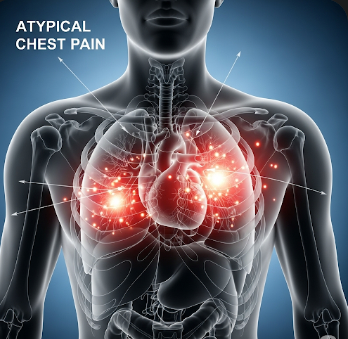Overview
Atypical chest pain refers to chest discomfort that does not follow the classic pattern of angina but may still signal underlying heart disease or other medical conditions. Unlike typical angina, which is often described as pressure or squeezing triggered by exertion, atypical chest pain can present as burning, stabbing, or localized pain, sometimes associated with shortness of breath, nausea, or fatigue.
In South Korea, cardiology clinics and emergency departments provide comprehensive evaluation, including ECG, imaging, and laboratory testing, to distinguish atypical chest pain from benign causes and ensure timely intervention when needed.
Key Facts
Highlights:
➡️ Atypical chest pain may mimic heartburn, muscle strain, or gastrointestinal discomfort.
➡️ It is more common in women, elderly patients, and individuals with diabetes.
➡️ Although often non-cardiac, it can still indicate coronary artery disease or other serious cardiac conditions.
➡️ Evaluation in specialized clinics ensures proper diagnosis and reduces the risk of missed heart disease.
➡️ South Korea provides advanced cardiology care, including non-invasive imaging and interventional procedures.
What is Atypical Chest Pain?
Atypical chest pain is chest discomfort that does not fit the classic angina pattern. Features may include:
- Pain that is sharp, stabbing, or burning, rather than pressure or tightness
- Discomfort that varies in location, including upper chest, back, jaw, or arms
- Pain not reliably triggered by exertion or relieved by rest
- May be episodic or persistent, sometimes associated with other systemic symptoms
It is important to recognize that atypical chest pain can mask serious cardiac conditions, particularly in high-risk populations.
What Symptoms are Related to Atypical Chest Pain?
Symptoms often vary widely and may overlap with non-cardiac causes:
- Localized or diffuse chest discomfort
- Shortness of breath or fatigue
- Palpitations or irregular heartbeat
- Nausea, vomiting, or indigestion-like symptoms
- Pain radiating to the neck, jaw, shoulder, or arm
- Dizziness or lightheadedness
- Symptoms triggered by stress, exertion, or certain positions
What Causes / Possible Causes of Atypical Chest Pain?
Highlights:
➡️ Cardiac Causes: Coronary artery disease, microvascular angina, pericarditis, or early-stage heart attack.
➡️ Gastrointestinal Causes: Gastroesophageal reflux disease (GERD), esophageal spasm, gastritis, or peptic ulcer disease.
➡️ Musculoskeletal Causes: Costochondritis, muscle strain, or rib injury.
➡️ Pulmonary Causes: Pulmonary embolism, pleuritis, or pneumonia.
➡️ Psychological Causes: Anxiety, panic attacks, or stress-related somatic pain.
➡️ Neurological Causes: Nerve compression or neuropathic pain affecting the chest wall.
➡️ Other Systemic Conditions: Thyroid disorders, anemia, or metabolic disturbances.
When Should I See My Doctor?
Highlights:
➡️ If chest pain is new, severe, or unexplained, seek immediate medical attention.
➡️ If pain is recurrent, persistent, or associated with shortness of breath, dizziness, or palpitations.
➡️ For patients with risk factors such as hypertension, diabetes, smoking, or family history of heart disease.
➡️ If gastrointestinal, musculoskeletal, or psychological causes are suspected, evaluation can clarify the diagnosis.
➡️ Early assessment reduces the risk of missing underlying heart disease or other serious conditions.
Care and Treatment
Management of atypical chest pain focuses on accurate diagnosis and targeted treatment based on the underlying cause.
Highlights:
➡️ Cardiac Evaluation: ECG, echocardiography, stress testing, or coronary angiography if cardiac causes are suspected.
➡️ Medications: Anti-anginal drugs, antacids, proton pump inhibitors, or muscle relaxants depending on the cause.
➡️ Lifestyle Modifications: Diet, exercise, stress management, and smoking cessation for cardiovascular or gastrointestinal health.
➡️ Physical Therapy: For musculoskeletal-related chest pain to improve posture and muscle strength.
➡️ Psychological Support: Counseling or cognitive behavioral therapy for anxiety or panic-related chest discomfort.
➡️ Emergency Care: Immediate intervention for high-risk patients with suspected cardiac events.
➡️ Regular Monitoring: Follow-up appointments to track symptom progression and response to treatment.
Treatment Options in Korea
South Korea offers advanced evaluation and treatment for atypical chest pain through multidisciplinary clinics:
Highlights:
➡️ Cardiology Centers: ECG, stress testing, echocardiography, and coronary angiography.
➡️ Gastroenterology Clinics: Evaluation for GERD, esophageal spasm, or other gastrointestinal causes.
➡️ Pulmonology Services: Assessment for pulmonary embolism, pleuritis, or lung disorders.
➡️ Musculoskeletal Care: Physical therapy and orthopedic evaluation for chest wall pain.
➡️ Psychological Clinics: Management of anxiety, stress, or panic-related chest pain.
➡️ Integrated Multidisciplinary Care: Collaboration among cardiologists, gastroenterologists, pulmonologists, and therapists.
➡️ Medical Tourism Support: Multilingual services, structured diagnostic pathways, and follow-up care for international patients.













